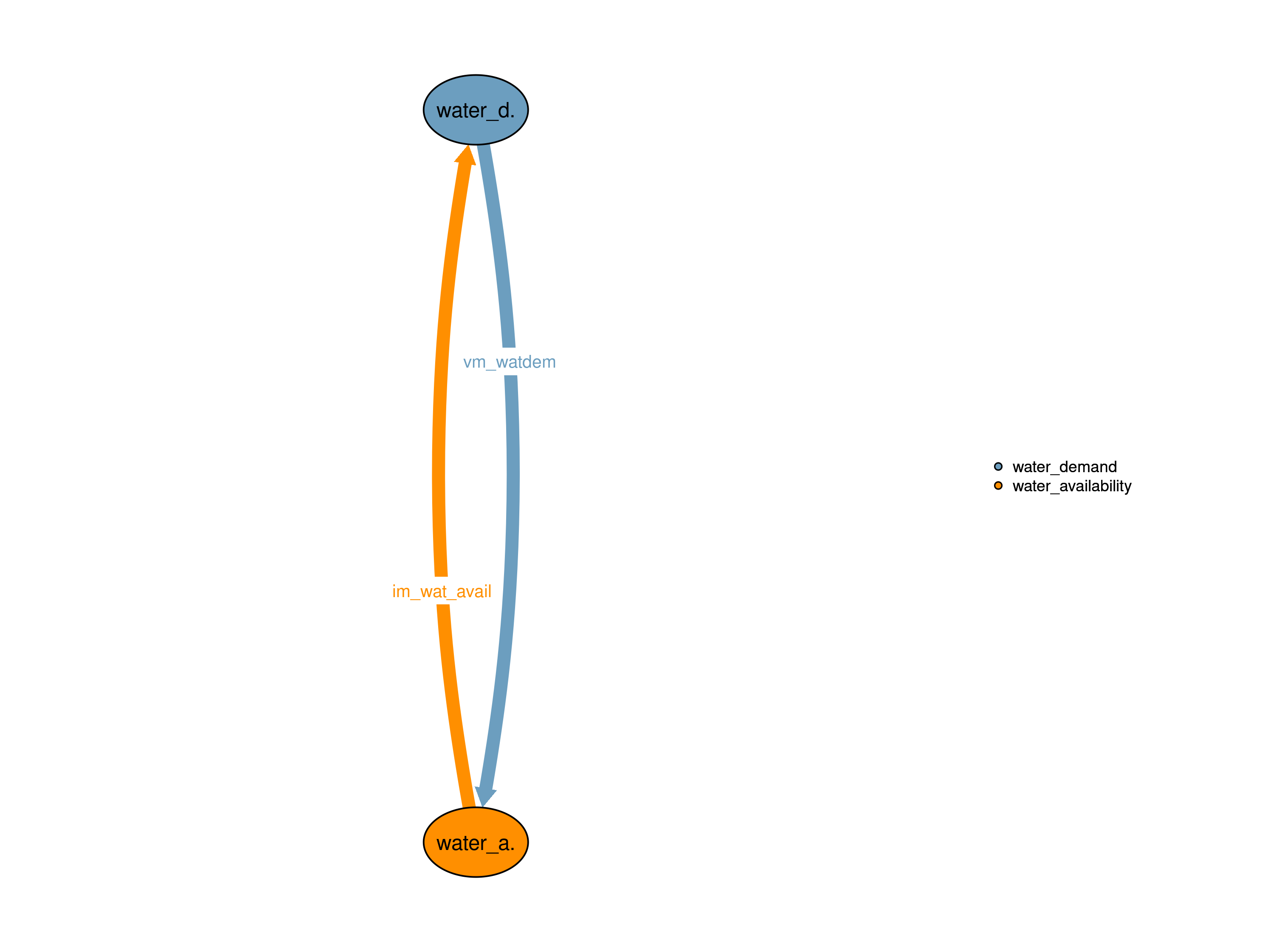The water availability module determines the water that is available in MAgPIE. The following water sources are currently implemented: surface water, groundwater, technical (like desalination etc.). Additionally, this module includes the main water constraint that requires water withdrawals to be smaller or equal to available water. Information is passed to and received from the 42_water_demand module.

| Description | Unit | A | |
|---|---|---|---|
| vm_watdem (wat_dem, j) |
Water demand from different sectors | \(10^6 m^3/yr\) | x |
| Description | Unit | |
|---|---|---|
| im_wat_avail (t, wat_src, j) |
Water availability | \(10^6 m^3/yr\) |
The calculation of available water as described below happens in the MAgPIE preprocessing. This realization only considers renewable water resources, i.e. runoff generated from precipitation. All runoff is assumed to enter rivers, neglecting groundwater recharge. Other water resources such as fossil groundwater, discharge from melting glaciers or desalination are also not considered. The calculation of available water per grid cell is based on LPJmL (Bondeau et al. (2007)) simulations. For each river basin, total annual runoff in the basin constitutes the amount of water available in one year. In order to account for the fact that water can only be supplied to the plants during the growing period, the mean growing period over all crops based on LPJmL sowing and harvesting dates (Bondeau et al. (2007)) is calculated in MAgPIE. Some data has been excluded from the calculation:
Winter crops in the northern hemisphere (sowing date later than June 29th and harvest date later than December 31st) because we assume that irrigation does not take place during winter time.
Data points with crop yields below 10% of the world average yield. Such a low yield indicates that the site is not appropriate for this specific crop and the LPJmL (Bondeau et al. (2007)) growing period simulation is likely to be distorted.
Therefore, water available for irrigation in each basin only consists of the total runoff occurring in the mean growing period in all basin cells except for cells where water storage in terms of dams is present (taken from Biemans et al. (2011)). In this case, total annual runoff is available.
The distribution of basin runoff in the growing period to the individual grid cells is done using LPJmL (Bondeau et al. (2007)) discharge as a weight.
There is an interface to the 42_water_demand module. If exogenous non-agricultural water demand exceeds available water the missing amount is available from groundwater to avoid infeasibility.
\[\begin{multline*} \sum_{wat\_dem}vm\_watdem(wat\_dem,j2) \leq \sum_{wat\_src}v43\_watavail(wat\_src,j2) \end{multline*}\]
The water constraint, q43_water, assures that, in each cluster, the sum of water withdrawals in all sectors vm_watdem does not exceed available water from all sources v43_watavail. The local seasonal water constraints is the sum of the amount of water needed in the sectors defined by wat_dem (agriculture, industry, electricity, domestic and ecosystem). This value must be lower than the sum of the Amount of water available from different sources in the sectors defined by wat_src (surface, ground, technical and renewable groundwater).
Limitations There are no known limitations.
| Description | Unit | A | |
|---|---|---|---|
| f43_wat_avail (t_all, j) |
Surface water available for irrigation per cell from LPJmL | \(10^6 m^3/yr\) | x |
| q43_water (j) |
Local seasonal water constraints | \(10^6 m^3/yr\) | x |
| v43_watavail (wat_src, j) |
Water available from different sources | \(10^6 m^3/yr\) | x |
| description | |
|---|---|
| cell(i, j) | Mapping between regions i and clusters j |
| j | Spatial clusters |
| j2(j) | Spatial Clusters (dynamic set) |
| t_all | 5-year time periods |
| t(t_all) | Simulated time periods |
| type | GAMS variable attribute used for the output |
| wat_dem | Water demand sectors |
| wat_src | Type of water source |
| watdem_exo(wat_dem) | Exogenous water demands |
Anne Biewald, Markus Bonsch
42_water_demand, 43_water_availability
Biemans, H., I. Haddeland, P. Kabat, F. Ludwig, R. W. A. Hutjes, J. Heinke, W. von Bloh, and D. Gerten. 2011. “Impact of Reservoirs on River Discharge and Irrigation Water Supply During the 20th Century.” Water Resources Research 47 (3). https://doi.org/10.1029/2009WR008929.
Bondeau, Alberte, Pascalle C. Smith, Sönke Zaehle And Sibyll Schaphoff, Wolfgang Lucht, Wolfgang Cramer, Dieter Gerten, Hermann Lotze-Campen, Christoph Müller, Markus Reichstein, and Benjamin Smith. 2007. “Modelling the Role of Agriculture for the 20th Century Global Terrestrial Carbon Balance.” Global Change Biology 13 (3): 679–706. https://doi.org/10.1111/j.1365-2486.2006.01305.x.